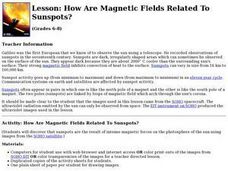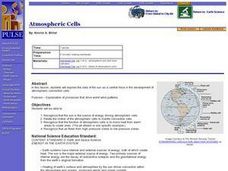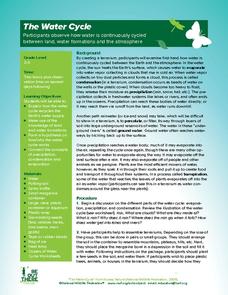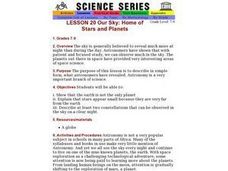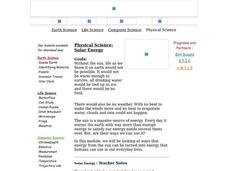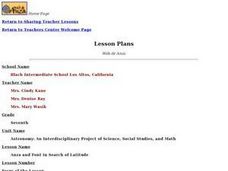Curated OER
How Are Magnetic Fields Related To Sunspots?
Learners discover that sunspots are the result of intense magnetic forces on the photosphere of the sun by observing images from the SOHO satellite.
Curated OER
Musical Plates
Sixth graders engage in a study of the plates and how they are part of the formation of the ever changing landscape of planet earth. They access web sites that have applications for observation and conducting different activities. The...
Curated OER
Satellite Mobiles
Students discuss satellites and their functions. They design and construct their own satellite out of readily available materials. Students are taught the definition of a satellite. They discuss the two main purposes of satellites:...
Curated OER
Sunspot Classification
Students study classification schemes for identifying sunspots. They distinguish between sunspot unbrae and penunbrae, measure sunspots, and compare them to the size of the Earth. They complete a worksheet showing classification of...
Curated OER
Atmospheric Cells
Students recognize that the sun is the source of energy driving atmosphere cells. They relate the motion of the atmospheric cells to mantle convection cells. Students recognize that the function of atmospheric cells is to move heat from...
Curated OER
Reasons for the Seasons
Students discover how the Earth's axis of rotation affects the angle of sunlight and the length of day. They take a survey and give the survey out to family members and friends. They tally their findings and then determine the correct...
Alabama Learning Exchange
Seasons
Learners explore the four seasons through literature, art activities and technology and explore how the earth's rotation around the sun results in the occurrence of the four seasons.
Curated OER
Quiz: Weather Phenomena #2
In this science worksheet, 3rd graders will focus on the weather. Students will respond to eight multiple choice and fill in the blank questions about various aspects pertaining to our weather.
Curated OER
The Water Cycle
Students are introduced to the components and importance of the water cycle. They are shown how groundwater moves using a model. Students list 9 places on earth where water is found. They define the terms cycle and water cycle.
Curated OER
Shadow Trackers
Students use online websites to inquire about the cycle of day and night. In this web based lesson, students are able to see the movement of the sun and Earth. Students can look at different parts of the Earth as if they were on the Sun...
Curated OER
As the World Turns
Students will use their bodies to act out the motions of Earth by exploring orbits, rotations, and the turning of the earth as it revolves around the sun. Doing research to find correct answers to their questions will help them act out...
Curated OER
Our Sky: Home of Stars and Planets
Students discover that astronomy is a branch of science that includes the study of planets, stars, and constellations.
Curated OER
Seasons
Students identify and define the vocabulary words: summer, spring, fall, and rotation. They describe how the earth's rotation affects the seasons. Students match appropriate clothing with each season. They discuss why a particular...
Curated OER
Tropical Atlantic Aerosols
Students analyze NASA data from the Multi-angle Imaging Spectroradiometer. In this NASA data lesson plan, students access an assigned website to examine information from the MISR on the Terra Satellite. They determine how desert dust...
Curated OER
Solar System Bead Distance Activity
Students create a scaled solar system model using colorful beads. In this space science lesson, students convert AU units into metric measurements. They arrange the planets according to their distances from the sun.
Curated OER
Lesson Plan # 1 - Phases of the Moon
Students explore and identify moon phases, watch teacher demonstration of different phases using globe and flashlight to represent moon and sun, and discuss reasons why there are moon phases.
Curated OER
Astronomy
Pupils explore the rotation of the Earth and observe the shapes of constellations. After discussing how the Earth moves. volunteers use a flashlight and globe to model the movement of the sun-Earth system. Using Digitalis technology,...
Curated OER
Space Weight, Gravity, and Distance
In this planets in space worksheet, high schoolers calculate their weight on the 9 planets plus calculate the distance of the planets from the sun in astronomical units. This worksheet has 6 fill in the blank and 3 short answer questions.
Curated OER
Meteor, Meteoroid, Meteorite: What's the Difference?
Students explore the difference between a meteor, meteorite and meteoroid. In this space science lesson, students first read information about these space bodies. Students make Comet Cookies and use them to model a meteor shower with a...
Curated OER
Melts in Your Bag, Not in Your Hands
Students study how the sun transfers heat to the earth through radiation. They examine how animals absorb energy from the sun to warm their bodies by experiment with chocolate melting. They examine sun safety.
Curated OER
Solar Energy
Students investigate solar energy. They explore ways that energy from the sun can be turned into energy that humans can use in our everyday lives. In various experiments, they explore the effect of clouds and dust on photovoltaic energy...
Curated OER
Quiz: Astronomy
In this science worksheet, 3rd graders will focus on various aspects of astronomy. Students will respond to ten questions all pertaining to stars, constellations, planets, and our solar system.
Curated OER
Sky Pictures
Young scholars investigate constellations. In this space science lesson, students view transparencies of constellations and identify the zodiac constellations. Young scholars research the legends connected with the constellations.
Curated OER
Anza and Font in Search of Latitude
This is an integrated lesson that incorporates Social Studies, Science, and Mathematics. In Social Studies, 7th graders complete an online interview and complete an online worksheet about latitude of sites on the Anza trail. In Science...


